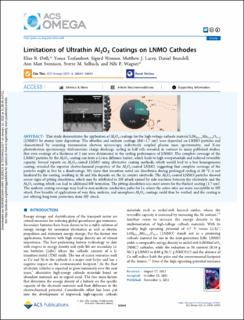| dc.description.abstract | This study demonstrates the application of Al2O3 coatings for the high-voltage cathode material LiNi0.5–xMn1.5+xO4−δ (LNMO) by atomic layer deposition. The ultrathin and uniform coatings (0.6–1.7 nm) were deposited on LNMO particles and characterized by scanning transmission electron microscopy, inductively coupled plasma mass spectrometry, and X-ray photoelectron spectroscopy. Galvanostatic charge discharge cycling in half cells revealed, in contrast to many published studies, that even coatings of a thickness of 1 nm were detrimental to the cycling performance of LNMO. The complete coverage of the LNMO particles by the Al2O3 coating can form a Li-ion diffusion barrier, which leads to high overpotentials and reduced reversible capacity. Several reports on Al2O3-coated LNMO using alternative coating methods, which would lead to a less homogeneous coating, revealed the superior electrochemical properties of the Al2O3-coated LNMO, suggesting that complete coverage of the particles might in fact be a disadvantage. We show that transition metal ion dissolution during prolonged cycling at 50 °C is not hindered by the coating, resulting in Ni and Mn deposits on the Li counter electrode. The Al2O3-coated LNMO particles showed severe signs of pitting dissolution, which may be attributed to HF attack caused by side reactions between the electrolyte and the Al2O3 coating, which can lead to additional HF formation. The pitting dissolution was most severe for the thickest coating (1.7 nm). The uniform coating coverage may lead to non-uniform conduction paths for Li, where the active sites are more susceptible to HF attack. Few benefits of applications of very thin, uniform, and amorphous Al2O3 coatings could thus be verified, and the coating is not offering long-term protection from HF attack. | en_US |

